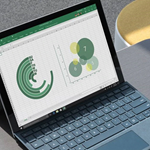
Research: A concrete way to measure IT’s impact on an employee’s at-work experience
There’s been a lot written about how Microsoft’s huge turnaround under Satya Nadella is the result of a culture change. When we analyze the things that drive culture and look for ways we can support other organizations who are making changes of their own, we consistently find that IT has an outsized number of opportunities to positively impact employee sentiment and loyalty—both of which are critical parts of any organization’s cultural transformation.
Improving employee sentiment and employee loyalty is also a critical way for an organization to attract winning talent. When workers have a modern workplace experience that is connected, flexible, and empowering, it sends a clear signal that they’re valued and they work for a forward-leaning organization.
Cultivating and positively reinforcing these attributes within your workforce is obviously valuable, but to make these changes replicable and actionable among our customers worldwide, we needed to study and quantify how this happens. We worked closely with leading experience management company, Qualtrics, as they’ve exhaustively studied how to do this.
Here’s what we learned.
Modernize the workplace experience
It’s not particularly revolutionary to say that some of the most advanced tools for productivity and user experience are found in Microsoft 365. This platform empowers users to work anywhere across their devices—and it has been built to meet and exceed the needs and expectations of users, IT, and security, so that it is valuable to every stakeholder in your organization. I like to refer to Microsoft 365 as loved by users, loved by IT, and trusted by all.
To really make the most of Microsoft 365 value, we worked with organizations to help them modernize their workplace experiences by deploying Microsoft 365 through our Microsoft Managed Desktop service. With Microsoft Managed Desktop, we manage these PCs on behalf of the customers, and they use Microsoft 365 as the foundation for their productivity/management/security. This setup is something I call “Microsoft 365 native.”
A Microsoft 365 native PC:
- Is a modern device with touch capabilities.
- Runs the Office 365 ProPlus cloud-attached apps.
- Is managed and secured with Microsoft 365.
- Provides a fast, responsive work experience that isn’t bogged down by extra agents that slow down the way you work.
The result can be seen in something I like to call “the most boring demo in the world,” which I think will blow you away.
For these customers, we deployed the Microsoft Managed Desktop baseline and set of policies to manage and secure the environment. The Microsoft Managed Desktop service leverages the built-in capabilities of Microsoft 365. We consider it the gold standard when it comes to the architectural approach, the required policies needed to secure devices, and the ways we believe PCs should be deployed, managed, and operated to exceed the expectations both users and IT.
As these initial organizations were moving into the Microsoft Managed Desktop service, we had an interesting opportunity to work with a few organizations to measure and concretely quantify the difference in employee sentiment between the users with a modern workplace and the Microsoft 365 native experience delivered by Microsoft Managed Desktop. Accounting for dozens of variables, the impact and results of this study were impressive.
Adopt what works at work for workers
One of the biggest things we learned had to do with the reaction to changes in the technology experience. Comparing the two control groups, the Microsoft 365 native devices (managed by the Microsoft Managed Desktop service) had a boot time that was 85 percent faster, an immediate resume experience, 2x the battery life, and 85 percent fewer crashes. Users of these Microsoft Managed Desktop-based Microsoft 365 native devices definitely noticed these improvements:
The real question, however, is how this kind of change in technology impacts employee sentiment and loyalty. This question is an area where Qualtrics’ expertise in measuring, analyzing, and understanding employee experiences discovered some fascinating data on just how significant the impact was.
Below is a page I took directly from the report they delivered to us:
The measurement I found most impactful deals with how much more valued these employees feel by their company when they have that Microsoft 365 native work environment. This increase in employee sentiment translates into happier and more fulfilled employees. Having happier employees directly impacts the customer experience your organization delivers, which in turn increases long-term employee loyalty.
The data from the couple of organizations in which we deployed the survey indicates that loyal employees stay with an organization longer, and this results in less employee churn, which results in the entire organization operating at a higher and more productive level. One of the most rewarding things we’ve done with this research is to show the results to the senior leaders of these companies and emphasize to them the impact of their IT organization.
Make it real for your organization
These insights from Qualtrics really illustrate the impact of modern management. When you deploy modern technology and manage it in a modern way, you can extend this same experience to your users. The Microsoft Managed Desktop service uses System Center Configuration Manager (ConfigMgr) and Microsoft Intune—what we now call Microsoft Endpoint Manager—to simplify management and ensure your users are having a great experience.

Announcing Microsoft Endpoint Manager
Learn how we’re integrating Microsoft Intune, Configuration Manager, and more into a single solution called Microsoft Endpoint Manager.
Through Microsoft Endpoint Manager, we’re also making it easier for you to manage Office 365 ProPlus across devices to ensure your employees are secure and productive no matter how they need to work. In addition to providing device health insights that let you monitor the upgrade readiness of your devices to the latest feature update of Office 365 ProPlus, we also announced deeper integration for managing Office 365 using Jamf Pro. Our integration with the new Application and Custom Settings experience (demonstrated at the Jamf Nation User Conference (JUNC) 2109 a few weeks ago) allows you to easily set Office 365 policies using a familiar forms-based interface.
If you’re administering Mac devices, you centrally configure security, privacy, and update policies to deliver the very best Office 365 experience on a Mac to your users. We’re committed to helping you to provide a great employee experience, no matter the device.
Next steps
The question you’re likely asking right now is, “How do I get this kind of experience into the hands of my users?” First, if you want to take advantage of the Microsoft Managed Desktop service and offload this work to the experts at Microsoft, you can easily learn more.

Microsoft Managed Desktop
Delight users, protect devices, and focus on your core business by modernizing your workplace with Microsoft Managed Desktop.
The new Productivity Score, announced last month, is being built to help guide you use the insights from both Employee Experience and Technology Experience to quantify the cultural impact of technology on your users. It also helps you understand the specific actions you can take to improve the management of each device to ensure your users are having a great experience.
To take advantage of Productivity Score, make sure you have enabled co-management by connecting ConfigMgr and Intune—now known as Microsoft Endpoint Manager. If you’re curious how to do this, check out my Mechanics video to learn how. In the meantime, work you can be doing is to take a hard look at three things, which are the most common causes of poor performance on your PCs:
- Take a deep look at all the agents you are deploying. The single largest cause of poor boot, resume, and battery life is loading the PC with too many agents. Do you really need what you have? Does what is built-in and part of Microsoft 365 meet your needs?
- Look at how many Group Policies are you applying. This has an impact the boot-to-productive time.
- Are you giving good hardware to your user? For example, if your devices have HDD drives instead of SSDs the performance impact is significant.
You can also benefit from your own research from Qualtrics. Like what we did with our Microsoft Managed Desktop service, you can gather a group of users to test the Microsoft 365 native deployment and then use Qualtrics to help you to measure the impact this native experience can have in your organization.
Learn more
To learn more about the Qualtrics data and Microsoft Managed Desktop, visit the Tech Community blog.
The post Research: A concrete way to measure IT’s impact on an employee’s at-work experience appeared first on Microsoft 365 Blog.
Source: Office Blog
—

